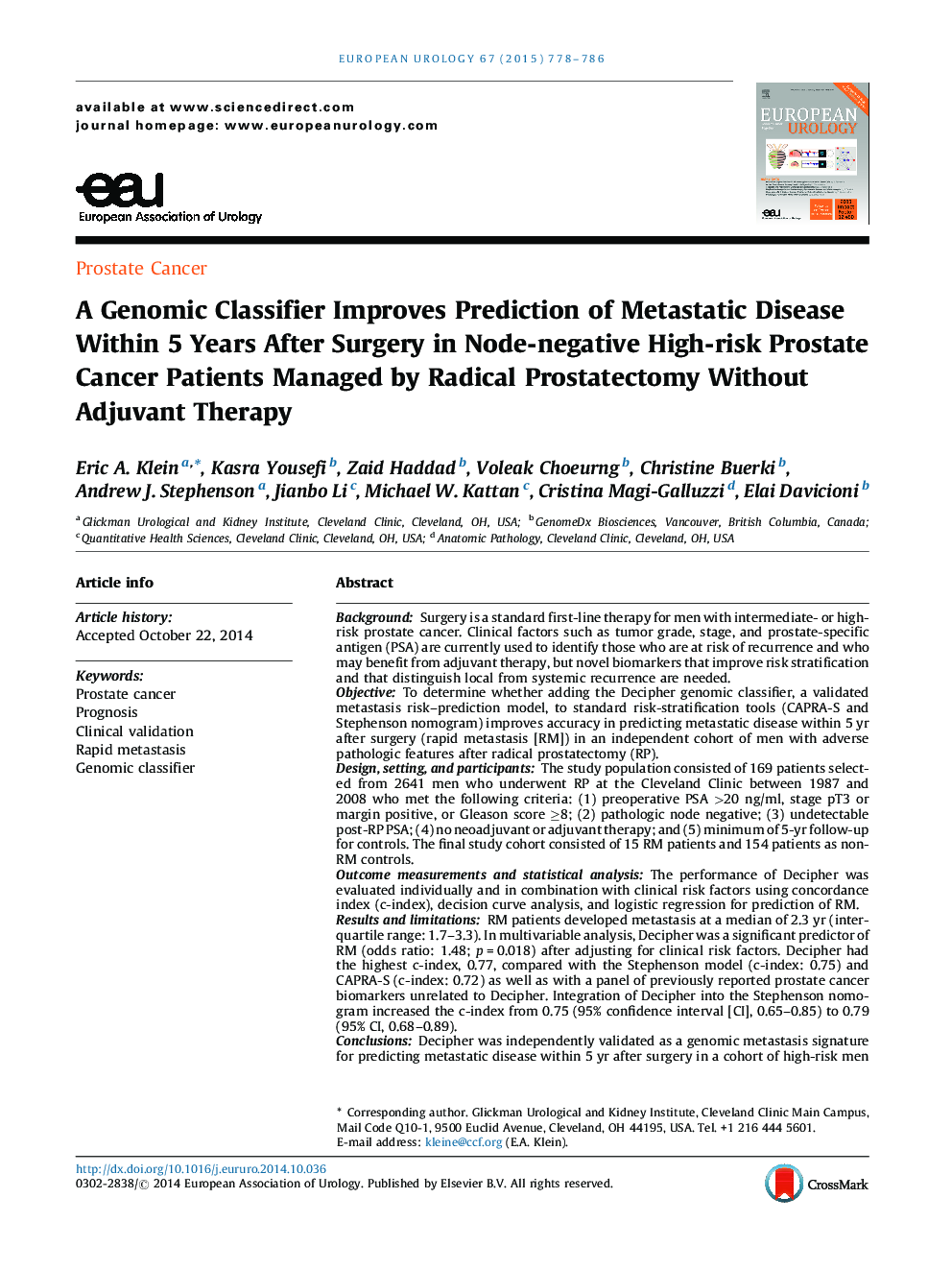| کد مقاله | کد نشریه | سال انتشار | مقاله انگلیسی | نسخه تمام متن |
|---|---|---|---|---|
| 6175307 | 1252959 | 2015 | 9 صفحه PDF | دانلود رایگان |
BackgroundSurgery is a standard first-line therapy for men with intermediate- or high-risk prostate cancer. Clinical factors such as tumor grade, stage, and prostate-specific antigen (PSA) are currently used to identify those who are at risk of recurrence and who may benefit from adjuvant therapy, but novel biomarkers that improve risk stratification and that distinguish local from systemic recurrence are needed.ObjectiveTo determine whether adding the Decipher genomic classifier, a validated metastasis risk-prediction model, to standard risk-stratification tools (CAPRA-S and Stephenson nomogram) improves accuracy in predicting metastatic disease within 5 yr after surgery (rapid metastasis [RM]) in an independent cohort of men with adverse pathologic features after radical prostatectomy (RP).Design, setting, and participantsThe study population consisted of 169 patients selected from 2641 men who underwent RP at the Cleveland Clinic between 1987 and 2008 who met the following criteria: (1) preoperative PSA >20 ng/ml, stage pT3 or margin positive, or Gleason score â¥8; (2) pathologic node negative; (3) undetectable post-RP PSA; (4) no neoadjuvant or adjuvant therapy; and (5) minimum of 5-yr follow-up for controls. The final study cohort consisted of 15 RM patients and 154 patients as non-RM controls.Outcome measurements and statistical analysisThe performance of Decipher was evaluated individually and in combination with clinical risk factors using concordance index (c-index), decision curve analysis, and logistic regression for prediction of RM.Results and limitationsRM patients developed metastasis at a median of 2.3 yr (interquartile range: 1.7-3.3). In multivariable analysis, Decipher was a significant predictor of RM (odds ratio: 1.48; p = 0.018) after adjusting for clinical risk factors. Decipher had the highest c-index, 0.77, compared with the Stephenson model (c-index: 0.75) and CAPRA-S (c-index: 0.72) as well as with a panel of previously reported prostate cancer biomarkers unrelated to Decipher. Integration of Decipher into the Stephenson nomogram increased the c-index from 0.75 (95% confidence interval [CI], 0.65-0.85) to 0.79 (95% CI, 0.68-0.89).ConclusionsDecipher was independently validated as a genomic metastasis signature for predicting metastatic disease within 5 yr after surgery in a cohort of high-risk men treated with RP and managed conservatively without any adjuvant therapy. Integration of Decipher into clinical nomograms increased prediction of RM. Decipher may allow identification of men most at risk for metastatic progression who should be considered for multimodal therapy or inclusion in clinical trials.Patient summaryUse of Decipher in addition to standard clinical information more accurately identified men who developed metastatic disease within 5 yr after surgery. The results suggest that Decipher allows improved identification of the men who should consider secondary therapy from among the majority that may be managed conservatively after surgery.
Journal: European Urology - Volume 67, Issue 4, April 2015, Pages 778-786
